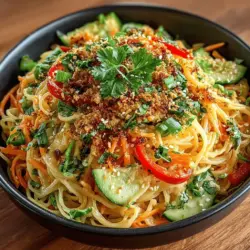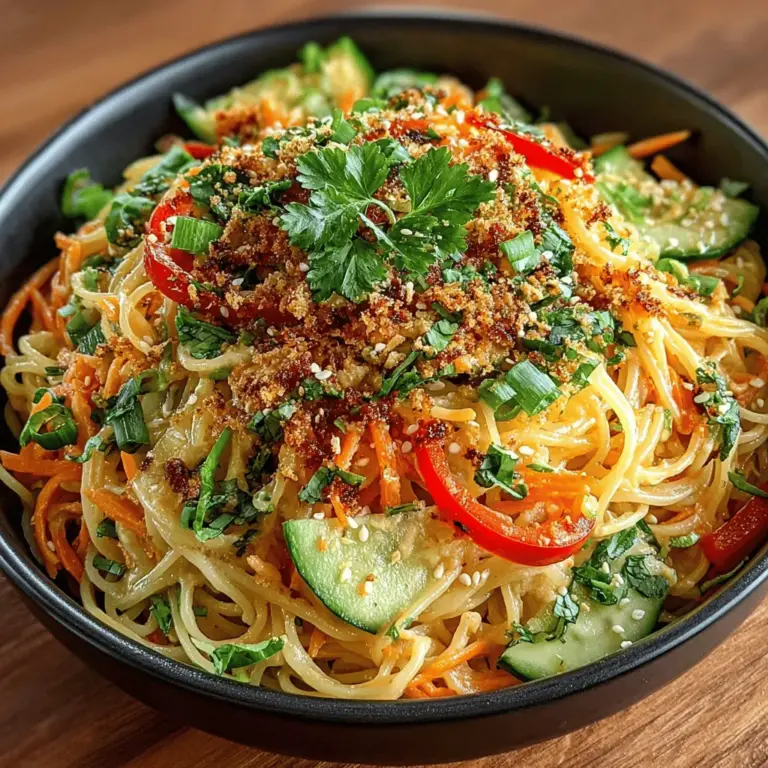As the sun blazes overhead and temperatures rise, the craving for light, refreshing dishes becomes impossible to ignore. Cold noodle dishes have long been a favorite in various cuisines, offering a delightful combination of textures and flavors that can be both satisfying and nourishing. Among these, Cold Peanut Sesame Noodles stand out for their creamy, nutty sauce and vibrant array of fresh vegetables. This dish not only tantalizes the taste buds but also serves as a versatile option for those seeking a quick meal, whether it be for a family dinner, a picnic, or a light lunch.
Cold Peanut Sesame Noodles are a celebration of simplicity and flavor, making them incredibly appealing during warmer months. The beauty of this dish lies in its easy preparation, allowing even those with the busiest schedules to whip it up in no time. Plus, its adaptability means it can cater to various dietary preferences, whether you’re vegan, vegetarian, or gluten-free. With a harmonious balance of protein, healthy fats, and fresh produce, this noodle dish is a nutritious choice that satisfies without the heaviness of traditional meals.
Understanding Cold Peanut Sesame Noodles
Origin of the Dish
The roots of peanut noodles can be traced back to multiple Asian culinary traditions, particularly within Chinese and Thai cuisines. These cultures have long appreciated the rich flavor of peanuts, which is often used in sauces and as a cooking ingredient. In China, cold noodle dishes are a staple during the hot summer months, and the incorporation of peanut sauce adds a creamy richness that perfectly complements the chewy texture of the noodles. Similarly, in Thailand, the use of peanuts in dishes like Pad Thai demonstrates the versatility and popularity of this ingredient.
Over the years, Cold Peanut Sesame Noodles have evolved into a beloved dish across the globe, with different regions adding their unique twists. Whether served as a street food delight or a home-cooked favorite, this dish brings people together, making it a common feature at summer gatherings, barbecues, and picnics.
Cultural Significance
In many cultures, food is not just about sustenance; it’s about connection and celebration. Cold Peanut Sesame Noodles are often enjoyed during festive occasions, family gatherings, and casual get-togethers. Their refreshing nature makes them the perfect companion for outdoor meals, where the focus is on enjoying the company of friends and family. In addition, the vibrant colors of the fresh vegetables used in the dish symbolize abundance and health, enhancing its appeal as a dish that not only tastes good but also looks inviting.
Ingredients Breakdown
To create the perfect bowl of Cold Peanut Sesame Noodles, you’ll need to gather a variety of ingredients that contribute to the dish’s unique flavor profile and nutritional benefits. Here’s a closer look at what you’ll need:
Noodles
The base of this dish can vary significantly, with choices ranging from traditional wheat-based noodles to gluten-free alternatives. Rice noodles are a popular choice, particularly in Asian cuisine, as they provide a light and chewy texture that pairs beautifully with the creamy peanut sauce. Alternatively, spaghetti can be used for a more Western twist, offering a familiar texture that many enjoy. For those adhering to a gluten-free diet, there are numerous options available, including gluten-free pasta varieties or even spiralized vegetables like zucchini for a low-carb alternative.
Peanut Sauce Components
– Creamy Peanut Butter: The star of the dish, creamy peanut butter, adds a rich texture and nutty flavor that is essential for a well-balanced sauce. Opt for natural peanut butter without added sugars or preservatives for the healthiest option.
– Low-Sodium Soy Sauce: This ingredient is crucial for providing depth and umami to the sauce. Choosing low-sodium allows you to enjoy the flavor without excessive salt intake. For a gluten-free alternative, tamari or coconut aminos can be excellent substitutes.
– Sesame Oil: A drizzle of sesame oil not only enhances the flavor but also introduces healthy fats into the dish. This oil is rich in antioxidants and has anti-inflammatory properties, making it a great addition to your diet.
– Sweeteners: The sweetness in the sauce balances the savory elements. Honey is a popular choice, but for vegans or those avoiding animal products, maple syrup can serve as an excellent alternative.
– Vinegar and Sriracha: A splash of vinegar adds tanginess to the sauce, while Sriracha introduces a kick of heat. Adjust these ingredients according to your personal taste preferences, making it as spicy or mild as you like.
Fresh Vegetables
Incorporating fresh vegetables not only boosts the nutrition of Cold Peanut Sesame Noodles but also adds a pleasing crunch and color. Carrots, cucumbers, bell peppers, and green onions are commonly used, each bringing its own unique flavor and texture to the dish. Carrots offer a sweet crunch, cucumbers provide hydration, bell peppers add sweetness and vibrancy, while green onions contribute a mild onion flavor that enhances the overall dish.
Garnishing Options
To elevate the presentation and flavor of your Cold Peanut Sesame Noodles, consider garnishing with sesame seeds, fresh cilantro, or mint. Sesame seeds add a delightful crunch and a nutty flavor, while herbs like cilantro and mint can bring a refreshing brightness to the dish. These garnishes not only enhance the visual appeal but also provide additional layers of flavor that elevate your dining experience.
Step-by-Step Instructions
Now that we’ve laid the groundwork by exploring the origins, cultural significance, and essential ingredients of Cold Peanut Sesame Noodles, it’s time to dive into the preparation process. Making this dish is straightforward and quick, making it perfect for busy weeknights or casual gatherings.
1. Cook the Noodles: Begin by boiling a pot of water. Once boiling, add your chosen noodles and cook according to the package instructions until they are al dente. This typically takes around 4 to 6 minutes for rice noodles or 8 to 10 minutes for spaghetti. Once cooked, drain the noodles and rinse them under cold water to halt the cooking process and cool them down.
2. Prepare the Peanut Sauce: In a mixing bowl, combine creamy peanut butter, low-sodium soy sauce, sesame oil, your choice of sweetener, a splash of vinegar, and a drizzle of Sriracha. Whisk the ingredients together until smooth. If the sauce appears too thick, you can thin it out with a bit of warm water until you reach your desired consistency.
3. Chop the Vegetables: While the noodles cool and the sauce comes together, take the time to chop your fresh vegetables. Julienne the carrots, slice the cucumbers and bell peppers, and finely chop the green onions. These should be prepared in bite-sized pieces for easy mixing and eating.
4. Combine Everything: In a large mixing bowl, combine the cooled noodles with the peanut sauce, ensuring that the noodles are well-coated. Add in the chopped vegetables and gently toss everything together, mixing until the vegetables are evenly distributed throughout the noodles.
5. Garnish: Finally, serve the Cold Peanut Sesame Noodles in individual bowls or on a large platter. Sprinkle with sesame seeds and your choice of fresh herbs for an extra touch of flavor and presentation.
By following these steps, you’ll have a delicious and refreshing dish ready to be enjoyed. Cold Peanut Sesame Noodles are not only quick to make but also offer a delightful blend of flavors and textures that are sure to impress. As we continue to explore this recipe, we’ll delve into variations, storage tips, and serving suggestions to elevate your dining experience even further.
{{image_2}}
Cooking the Noodles
To achieve the perfect texture for your cold peanut sesame noodles, start by bringing a large pot of water to a rolling boil. The type of noodles you use can vary, but traditional choices include Asian wheat noodles, rice noodles, or even soba noodles. Each type has its specific cooking time, so be sure to check the package instructions.
Once the water is boiling, add a generous pinch of salt. This step not only elevates the flavor of the noodles but also helps in maintaining their desired texture. Add the noodles to the pot and stir gently to prevent them from sticking together. It’s crucial to avoid overcooking; noodles should be cooked until just al dente, as they will continue to soften when mixed with the sauce and chilled.
After about 4 to 7 minutes (depending on the noodle type), taste a strand to ensure it has a slight bite left. Once ready, drain the noodles in a colander and rinse them under cold water to halt the cooking process. This step is essential for cold noodle dishes, as it cools them down rapidly and prevents them from becoming mushy. Toss the noodles with a splash of sesame oil to keep them from sticking and to add an extra layer of flavor.
Preparing the Peanut Sauce
Creating a smooth and creamy peanut sauce is the heart of this dish. Start with high-quality peanut butter as your base. Whether you prefer creamy or crunchy is up to you, but creamy peanut butter will yield a smoother sauce. In a mixing bowl, combine the peanut butter with soy sauce, rice vinegar, sesame oil, and a touch of honey or maple syrup for sweetness.
To enhance the flavor profile, consider adding minced garlic and freshly grated ginger. For a bit of heat, a dash of chili paste or sriracha can be included. Mix the ingredients with a whisk or fork until combined, then gradually add warm water—this helps to achieve the desired consistency. Adjust the amount of water based on how thick or thin you prefer your sauce. If you like it sweeter, add more honey; if you prefer a tangy flavor, increase the rice vinegar. Taste and adjust as necessary to ensure the sauce suits your palate.
Mixing the Ingredients
Now that your noodles and peanut sauce are ready, it’s time to bring everything together. In a large mixing bowl, add the chilled noodles and pour the peanut sauce over them. To ensure that every strand of noodle is evenly coated, use a pair of tongs or chopsticks to gently toss the noodles. Be careful not to break them; a light touch will keep them intact.
Next, incorporate your choice of fresh vegetables. Common options include shredded carrots, sliced bell peppers, and snap peas. These not only add vibrant colors but also provide additional texture and nutrition. Toss everything together until the vegetables are well distributed and coated in the sauce. For an added crunch, sprinkle some chopped peanuts on top just before serving.
Chilling for Flavor
Chilling your assembled dish is not just a matter of temperature; it plays a significant role in enhancing the flavors. When the noodles and sauce are given time to chill in the refrigerator for at least 30 minutes, the flavors meld and intensify. The cold temperature also brings out the freshness of the vegetables and creates a refreshing, satisfying dish, perfect for warm weather.
Chilling allows the peanut sauce to thicken slightly, adhering better to the noodles. This is a key step in ensuring that each bite is packed with flavor. If you’re preparing this meal ahead of time, it can be stored in an airtight container in the fridge for up to three days, making it a perfect option for meal prep.
Serving Suggestions
When it comes to presentation, a little effort can go a long way. Serve your cold peanut sesame noodles in shallow bowls or on a large platter for a communal style. Garnish with fresh herbs like cilantro or green onions to add color and a burst of freshness. You might also consider topping the dish with sesame seeds, providing a nutty crunch and enhancing the visual appeal.
For a complete meal, consider pairing the noodles with grilled chicken, shrimp, or tofu for added protein. This not only enriches the dish nutritionally but also complements the flavors beautifully. Serve with lime wedges on the side for an extra zesty kick that diners can add according to their taste.
Nutritional Benefits of Cold Peanut Sesame Noodles
Balanced Meal
Cold peanut sesame noodles are not only delicious but also a balanced meal option. The dish is rich in carbohydrates from the noodles, providing necessary energy, while the peanut sauce contributes healthy fats and protein. The addition of fresh vegetables ensures a good supply of vitamins and minerals, making this dish both nutritious and satisfying.
Plant-Based Protein
Peanuts are a fantastic source of plant-based protein, making this dish ideal for vegetarians and vegans. They are also rich in essential nutrients like magnesium, phosphorus, and vitamin E. The incorporation of vegetables adds fiber, enhancing digestion and keeping you fuller for longer.
Low-Calorie Option
Despite its rich flavor profile, cold peanut sesame noodles can remain a low-calorie option when prepared thoughtfully. By controlling the portion sizes of the sauce and opting for more vegetable content, you can enjoy a hearty meal that fits nicely within a healthy diet without sacrificing taste or satisfaction.
Versatility of the Recipe
Customization Options
One of the best features of cold peanut sesame noodles is their versatility. You can easily customize the ingredients based on what you have on hand or personal preferences. Swap out the vegetables for your favorites—zucchini, cucumbers, or broccoli work wonderfully.
For protein additions, consider incorporating grilled chicken, shrimp, or even marinated tofu for a plant-based option. Each variation allows you to tailor the dish to your nutritional needs and taste preferences, making it adaptable for anyone.
Meal Prep Friendly
These noodles are also meal prep-friendly. You can prepare the noodles and sauce in advance, storing them separately until you’re ready to eat. This makes it convenient for busy weekdays, allowing you to have a nutritious and enjoyable meal ready in minutes. Simply toss everything together and enjoy a satisfying lunch or dinner without the hassle of cooking.
Seasonal Variations
Summer Refreshments
During the warmer months, feel free to experiment with seasonal vegetables and herbs. Adding fresh produce like bell peppers, cucumbers, and radishes enhances the dish’s refreshing qualities. You might also consider incorporating fresh herbs such as basil or mint for an added layer of flavor that screams summer.
Winter Comfort
As the seasons change, adapt your cold peanut sesame noodles to suit the colder months. Incorporate warm ingredients such as sautéed mushrooms or roasted Brussels sprouts for a comforting twist. Adding spices like cayenne or smoked paprika can infuse warmth and depth into the dish, making it more suitable for winter dining.
Conclusion
Cold peanut sesame noodles are a delightful addition to any culinary repertoire, offering a perfect blend of flavor, nutrition, and versatility. This dish can easily be adapted to accommodate seasonal ingredients, dietary preferences, and personal tastes, making it suitable for any occasion. Whether enjoyed as a quick lunch, a picnic staple, or a refreshing dinner, these noodles promise to satisfy.
Encourage your culinary creativity by experimenting with different vegetables and proteins, and enjoy the nutritional benefits that come with each delicious bite. As you embark on your cooking journey, let these cold peanut sesame noodles become a staple in your home. Give this recipe a try, and you may just discover your new favorite dish.



